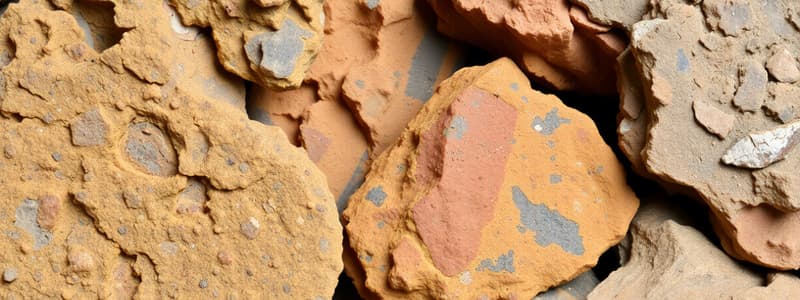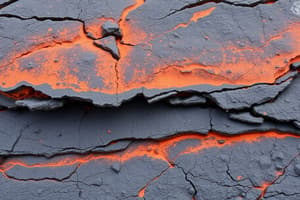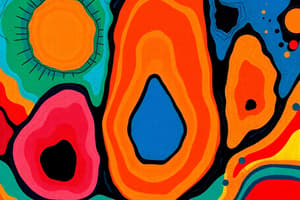Podcast
Questions and Answers
What is the primary factor used to classify rocks into igneous, sedimentary, and metamorphic types?
What is the primary factor used to classify rocks into igneous, sedimentary, and metamorphic types?
- Age of the rock
- Origin of formation (correct)
- Mineral hardness
- Physical characteristics
Which term refers to the science that studies the mineral composition and origin of rocks?
Which term refers to the science that studies the mineral composition and origin of rocks?
- Mineralogy
- Sedimentology
- Petrology (correct)
- Geology
Which type of rock is formed from the solidification of magma or lava?
Which type of rock is formed from the solidification of magma or lava?
- Igneous rock (correct)
- Sedimentary rock
- Volcanic rock
- Metamorphic rock
What process transforms fragmented materials into sedimentary rocks?
What process transforms fragmented materials into sedimentary rocks?
Which of the following is an example of an intrusive igneous rock?
Which of the following is an example of an intrusive igneous rock?
What type of sedimentary rock is formed from chemical processes?
What type of sedimentary rock is formed from chemical processes?
Which characteristics are most significant in the classification of igneous rocks?
Which characteristics are most significant in the classification of igneous rocks?
The term 'detrital rocks' refers to which kind of rocks?
The term 'detrital rocks' refers to which kind of rocks?
What is the primary texture characteristic of extrusive igneous rocks?
What is the primary texture characteristic of extrusive igneous rocks?
Which type of igneous rock forms from magma that cools slowly at great depths?
Which type of igneous rock forms from magma that cools slowly at great depths?
What is the primary characteristic of metamorphic rocks?
What is the primary characteristic of metamorphic rocks?
What distinguishes dynamic metamorphism from thermal metamorphism?
What distinguishes dynamic metamorphism from thermal metamorphism?
What is the process called when rocks are altered chemically and recrystallized?
What is the process called when rocks are altered chemically and recrystallized?
Which of the following metamorphic rocks is typically formed from shale?
Which of the following metamorphic rocks is typically formed from shale?
What is 'foliation' in metamorphic rocks?
What is 'foliation' in metamorphic rocks?
Which type of metamorphism occurs due to high temperatures from magma or lava?
Which type of metamorphism occurs due to high temperatures from magma or lava?
During which stage of the rock cycle do metamorphic rocks form?
During which stage of the rock cycle do metamorphic rocks form?
Which process allows metamorphic rocks to contribute to the formation of sedimentary rocks?
Which process allows metamorphic rocks to contribute to the formation of sedimentary rocks?
What type of metamorphism is primarily caused by tectonic forces?
What type of metamorphism is primarily caused by tectonic forces?
What is banding in metamorphic rocks?
What is banding in metamorphic rocks?
Which characteristic of minerals describes the external shape determined by the internal arrangement of molecules?
Which characteristic of minerals describes the external shape determined by the internal arrangement of molecules?
What is defined as the property of a mineral breaking along specific planes?
What is defined as the property of a mineral breaking along specific planes?
What color is malachite known for?
What color is malachite known for?
How many elements primarily compose about 98% of the earth's crust?
How many elements primarily compose about 98% of the earth's crust?
When does a mineral exhibit an irregular break without specific planes?
When does a mineral exhibit an irregular break without specific planes?
Which of the following mineral groups are commonly occurring minerals in the earth's crust?
Which of the following mineral groups are commonly occurring minerals in the earth's crust?
What does the lustre of a mineral refer to?
What does the lustre of a mineral refer to?
Which physical characteristic of a mineral is described by its ability to resist scratching?
Which physical characteristic of a mineral is described by its ability to resist scratching?
What is the primary source of all minerals in the earth?
What is the primary source of all minerals in the earth?
In which mineral form does silicon typically combine with oxygen in the earth's crust?
In which mineral form does silicon typically combine with oxygen in the earth's crust?
What is the hardness of quartz on the Mohs scale?
What is the hardness of quartz on the Mohs scale?
Which of the following minerals has the lowest hardness on the Mohs scale?
Which of the following minerals has the lowest hardness on the Mohs scale?
Which of the following is considered a ferrous metal?
Which of the following is considered a ferrous metal?
What characteristic differentiates opaque minerals from translucent minerals?
What characteristic differentiates opaque minerals from translucent minerals?
Which of the following minerals can be classified as a precious metal?
Which of the following minerals can be classified as a precious metal?
Which mineral gives a white streak despite being purple or green in color?
Which mineral gives a white streak despite being purple or green in color?
Which type of rock is primarily associated with the formation of metallic minerals?
Which type of rock is primarily associated with the formation of metallic minerals?
What does the term 'streak' refer to in mineralogy?
What does the term 'streak' refer to in mineralogy?
Which of the following describes non-metallic minerals?
Which of the following describes non-metallic minerals?
Which mineral is ranked directly above corundum on the Mohs hardness scale?
Which mineral is ranked directly above corundum on the Mohs hardness scale?
Flashcards are hidden until you start studying
Study Notes
What is Rock?
- Rock is the solid mineral material forming the surface of the earth.
- Rocks are composed of one or more minerals.
- Petrology is the science of all things related to rocks, including composition, structure, texture, origin, occurrence, alteration, and relationships with other rocks.
- The age of a rock is determined based on carbon-14 dating.
Rock Classifications
- Rocks are classified into three types: Igneous, Sedimentary, and Metamorphic.
Igneous Rocks
- "Ignis" is Latin for "fire."
- Igneous rocks are formed from magma and lava from the earth's interior.
- Igneous rocks are formed when magma cools and solidifies.
- There are two types of igneous rocks:
- Intrusive rocks are formed when magma cools within the Earth's crust.
- Extrusive rocks are formed when lava cools on the Earth´s surface.
- Igneous rocks are also classified based on the texture, size, and arrangement of grains.
- Slow cooling at depth results in large mineral grains.
- Sudden cooling at the surface results in small, smooth grains.
- Examples of igneous rocks: Pegmatite, gabbro, granite, basalt, tuff
Sedimentary Rocks
- Sedimentary rocks are also called detrital rocks.
- The word "sedimentary" is derived from the Latin word "sedimentum," which means "settling."
- Sedimentary rocks are formed from rock fragments that have been weathered, transported, and deposited.
- The process of turning deposited sediments into rock is called lithification.
- Sedimentary rocks occupy only 5% of the Earth's surface.
- Sedimentary rocks are layered or stratified.
- Three types of sedimentary rocks based on their formation:
- Mechanically formed sedimentary rocks (e.g., conglomerate, loess, limestone, sandstone)
- Chemically formed sedimentary rocks (e.g., potash, halite)
- Organically formed sedimentary rocks (e.g., chalk, coal, limestone, geyserites)
Metamorphic Rocks
- The word "metamorphic" means "change of form."
- Metamorphic rocks are formed when existing rocks are transformed by pressure, volume, and temperature changes.
- Metamorphism is the process of recrystallization and reorganization of materials within existing rocks.
- Igneous and metamorphic rocks together account for 95% of the Earth's crust.
- Two types of metamorphism:
- Dynamic metamorphism: Breaking and crushing of minerals within rocks with no significant chemical changes.
- Thermal metamorphism: Chemical alteration and recrystallization of rock materials.
- Contact metamorphism: Rocks come in contact with hot magma or lava.
- Regional metamorphism: Recrystallization due to tectonic shearing, high temperature, or pressure.
- Foliation, a layered appearance, is common in metamorphic rocks.
- Banded rocks are a type of metamorphic rock where minerals form alternating layers in light and dark shades.
- Examples of metamorphic rocks: Slate, diamond, marble, quartzite, schist, gneiss.
The Rock Cycle
- The rock cycle is a continuous process where old rocks are transformed into new ones.
- Igneous rocks are primary rocks, and sedimentary and metamorphic rocks are derived from them.
- Igneous and metamorphic rocks can break into fragments that form sedimentary rocks.
- Crustal rocks can be carried down into the Earth's mantle through subduction, melt, and turn into magma, which is the source of igneous rocks.
- The rock cycle is a continuous process.
Minerals
- 98% of the Earth's crust is composed of eight elements: oxygen, sodium, calcium, iron, magnesium, silicon, aluminum, and potassium.
- The remaining 2% of the crust is made up of titanium, hydrogen, phosphorus, manganese, carbon, sulfur, nickel, and other elements.
- These elements combine to form minerals, which are naturally occurring, inorganic substances with a definite composition and physical properties.
- About 2000 minerals have been found in the Earth's crust, but most are related to six major rock-forming minerals.
- The hot magma in the Earth's interior is the source of all minerals.
Physical Characteristics of Minerals
- External crystal forms: Determined by the internal arrangement of molecules (e.g., cubic, tetrahedral, tabular, hexagonal)
- Cleavage: The property of breaking along specific planes (due to weaker bonding between atoms along some planes.)
- Fracture: Breaking in an irregular manner when the internal molecular arrangement is complex.
- Lustre: The shining quality of a mineral (metallic, glossy, silky, etc.)
- Color: Depends on molecular structure, but impurities can affect color (e.g., quartz can be red, white, green)
- Streak: The color of the mineral's powder.
- Specific gravity: The ratio of a mineral's weight to the weight of an equal amount of water.
- Hardness: A mineral's ability to resist scratching, measured by the Mohs Hardness Scale. The Mohs Scale uses 10 minerals with increasing hardness, from talc (1) to diamond (10).
- Structure: Arrangement of individual crystals.
- Transparency: Whether light passes through (transparent), passes through but is diffused (translucent), or doesn't pass through (opaque).
Mineral Classifications:
- Metallic Minerals: Composed of metals.
- Precious metals: Platinum, gold, silver
- Ferrous metals: Iron mixed with other metals
- Non-ferrous metals: Metals other than iron (e.g., copper, aluminum, lead, zinc, tin)
- Non-Metallic Minerals: Composed of non-metals (e.g., sulfur, silicon, phosphorus). Cement is a mixture of non-metallic minerals.
Studying That Suits You
Use AI to generate personalized quizzes and flashcards to suit your learning preferences.




